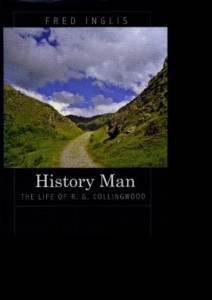History Man: the life of R. G. Collingwood
Published in 18th–19th - Century History, 20th-century / Contemporary History, Book Reviews, Issue 2 (March/April 2010), Reviews, Volume 18History Man: the life of R. G. Collingwood
Fred Inglis
(Princeton University Press, Ä33.55)
IBSN 9780691130149
 Robin George Collingwood was born on 22 February 1889 in the English Lake District and died there on 9 January 1943. He wrote extensively on the philosophy of art, metaphysics, the nature of knowledge, archaeology and religion, but his fame today rests largely on his philosophy of history, developed in The principles of history, The idea of history and An autobiography (1939). His unique approach was to seek common ground between philosophy and the practice of history.
Robin George Collingwood was born on 22 February 1889 in the English Lake District and died there on 9 January 1943. He wrote extensively on the philosophy of art, metaphysics, the nature of knowledge, archaeology and religion, but his fame today rests largely on his philosophy of history, developed in The principles of history, The idea of history and An autobiography (1939). His unique approach was to seek common ground between philosophy and the practice of history.
Now, two generations after his death, Fred Inglis has written the first full-length biography of Collingwood, depicting him variously as a distinguished archaeologist, an intellectual outsider while at Oxford, a charismatic and gifted teacher and an intrepid sailor. The biography reveals how Collingwood, towards the end of his life and in failing health, fell in love with a beautiful young actress, Kathleen Edwardes—a matter ‘never mentioned in any of the commentaries’. Struck down by a series of strokes, Collingwood ended his days in a wheelchair and died before his 54th birthday.
Collingwood was ‘writing total history a year or two before the Annalistes opened their revolution’ and anticipated Foucault by nearly half a century. His vision for history was rooted in the belief that society stood ‘on the threshold of an age in which history would be as important for the world as natural science had been between 1600–1900’. He rejected the ‘scissors-and-paste’ approach to history, which required would-be historians to look to the ‘authorities’, then cut and paste from them an uncritical version of the past.
By 1928 his history methodology included the controversial notion that ‘all history was the history of thought’, and that the function of the historian, qua historian, was to re-enact in his own mind the thoughts/events whose history he was studying. Historians have disputed what Collingwood meant by this, and Inglis rightly questions whether the concept warrants the ‘heavy perspiration of so much commentary by the Collingwoodians’ themselves. Less controversial, and also Collingwood’s favourite analogy, was to compare the historian to the hero in detective novels. He himself was an avid reader of the novels of Agatha Christie and the crime writer Dorothy Sayers, creator of Lord Peter Wimsey, the gentleman detective. He endorsed their intellectual method as a mode of historical inquiry.
During the last ten years of his life Collingwood’s world went into a tailspin. In 1932 he suffered a serious breakdown owing to overwork. In February 1938 he suffered a stroke and Oxford gave him a year off. During that summer, while at home at Coniston in the Lake District, mortally sick, he wrote An autobiography at speed. It is the story of the growth of a thinker’s mind and it has never gone out of print—testimony that it is the best introduction to Collingwood’s ideas. This reviewer can vouch for that, as his copy is a well-thumbed, heavily highlighted, old Pelican edition (all 112 pages) picked up in Greene’s bookshop in Dublin for a paltry sum in 1991. This period in his life marked the emergence of an ‘ivory tower’ intellectual to ‘fight in the daylight’. Collingwood recalled that when ancient Rome was in danger it was the cackling of sacred geese that saved the city. He fittingly saw himself as some class of professional goose now that European civilisation was perceived to be under threat by the Nazi menace. He considered that ‘cackling is my job and cackle I will’.
He didn’t cackle for long. When he died, Malcolm Knox, his favourite pupil, had the job of editing his papers. According to Inglis, Knox totally misunderstood Collingwood and destroyed some of his documents. Despite this, when The idea of history was published in 1946 a whole new Collingwood industry emerged, spearheaded by American scholars. It soon became popular to refer to him as ‘the best known neglected thinker of our time’. The final chapter in Inglis’s book affirms Collingwood’s influence on generations of scholars, and he singles out the role, the intellectual vigour and the commitment of David Boucher, founder of the Collingwood Society.
Given Collingwood’s place in the canon of historiography, it is surprising that it has taken so long for a full-length biography to appear. It is Inglis’s contention that Collingwood died prematurely ‘before his work was done’. Collingwood is portrayed as a person of multifaceted talents—a ‘scholar-genius, sportsman, intellectual . . . a local figure, lover, parent, sailor, mortal invalid and a dozen more’. The portrait is not convincing. Collingwood’s daughter, Teresa Smith, herself an Oxford academic, refused to cooperate with the biography, claiming that Inglis was the wrong person to write it. She disagreed with the view of Collingwood as a debonair philosopher-sportsman-sailor. Inglis suspects that the non-cooperation by Ms Smith meant that there was an unseen hoard of Collingwood’s letters inaccessible to him—a pity. It would have made a huge difference to a work that struggles to link the intellectual and personal sides of Collingwood’s life. Though hardly the awaited definitive biography, the book is a useful and erudite addition to Collingwood studies. HI
Austin Stewart is a writer and historian with a current research interest in local government history.
















